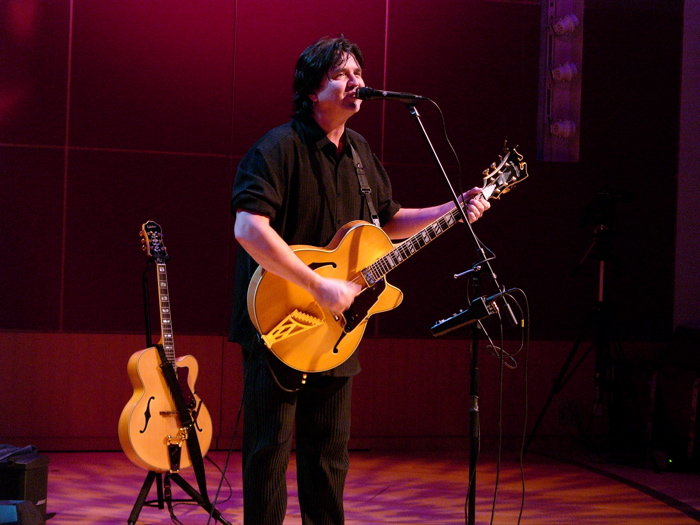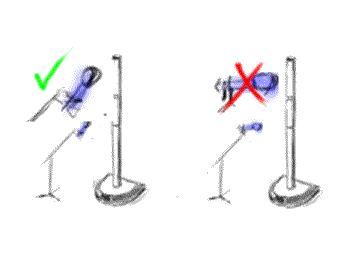Difference between revisions of "Microphone Feedback"
(add ferrin photo) |
(continuing to edit...) |
||
| Line 1: | Line 1: | ||
Proper Gain Staging is essential to avoiding feedback. Please take 2 minutes to review this short video. Although this is based on the Classic and Model I, the principles are generally applicable. | Proper Gain Staging is essential to avoiding feedback. Please take 2 minutes to review this short video. Although this is based on the Classic and Model I, the principles are generally applicable. | ||
| + | |||
| + | |||
== Gain Staging == | == Gain Staging == | ||
| Line 10: | Line 12: | ||
* If you are using vocal effects like reverb, chorus or delay, turn them off until you can get sufficient [[Gain Before Feedback|gain before feedback]] to get performance level volume. Then add the effects back into the signal chain (one at a time) so you can be aware of the individual impacts that each effect is having on feedback. | * If you are using vocal effects like reverb, chorus or delay, turn them off until you can get sufficient [[Gain Before Feedback|gain before feedback]] to get performance level volume. Then add the effects back into the signal chain (one at a time) so you can be aware of the individual impacts that each effect is having on feedback. | ||
| − | * Get close to the microphone. No other technique has a big an impact on feedback. Each halving of distance is approximately another 6 dB of gain before feedback. This means that the difference between working a microphone at 2 inches, and 1/4 inch is | + | * Get close to the microphone. No other technique has a big an impact on feedback. Each halving of distance is approximately another 6 dB of [[gain before feedback]]. This means that the difference between working a microphone at 2 inches, and 1/4 inch is 18 dB, which is more than twice as loud. |
| − | [[Image:Ferrin_eat_mic.jpg]] | + | [[Image:Ferrin_eat_mic.jpg|Charlie Ferrin at Bose: Nov. 9, 2007]] |
| − | * Use a directional microphone. Hypercardioid is better than cardioid, which is | + | * Use a directional microphone. Hypercardioid is better than cardioid, which is better than omnidirectional. All sound waves impinging on the microphone from a direction other than the intended signal is "noise" and will lower the threshold of feedback. |
| − | * Use as few open microphones as possible. When a microphone is not in use, turn it off. | + | * Use as few open microphones as possible. When a microphone is not in use, if possible, turn it off. |
* When stand mounting a directional microphone, tilt the microphone up ten or twenty degrees off the horizon so that it is less sensitive to direct sound from the speakers. | * When stand mounting a directional microphone, tilt the microphone up ten or twenty degrees off the horizon so that it is less sensitive to direct sound from the speakers. | ||
| Line 26: | Line 28: | ||
[stopped editing here] | [stopped editing here] | ||
| − | |||
| − | |||
| − | |||
| − | |||
| − | |||
| − | |||
| − | |||
* Upgrade your power stand to newer software that offer a high gain preset. see: Software Upgrading (This covers firmware update and Version 2.0 [[Presets/Model I and Classic|Presets]]) | * Upgrade your power stand to newer software that offer a high gain preset. see: Software Upgrading (This covers firmware update and Version 2.0 [[Presets/Model I and Classic|Presets]]) | ||
| − | |||
| − | |||
| − | |||
| − | |||
From the Official Product FAQs <ref>[http://www.bose.com/controller?event=VIEW_STATIC_PAGE_EVENT&url=/musicians/support/product_faqs.jsp&ck=0#question40 Official Product FAQs]</ref>. | From the Official Product FAQs <ref>[http://www.bose.com/controller?event=VIEW_STATIC_PAGE_EVENT&url=/musicians/support/product_faqs.jsp&ck=0#question40 Official Product FAQs]</ref>. | ||
Techniques that control feedback with a conventional system help with the Personalized Amplification System™ approach also. | Techniques that control feedback with a conventional system help with the Personalized Amplification System™ approach also. | ||
| − | |||
| − | |||
| − | |||
| − | |||
| − | |||
== Other general notes == | == Other general notes == | ||
* All players should be playing / singing through the L1™ System closest to them | * All players should be playing / singing through the L1™ System closest to them | ||
| − | |||
* Wherever possible "acoustic" instruments should use pickups instead of microphones. This is important because many players find it a struggle to keep a consistent and close distance between the microphone and their instrument. Also, an instrument can be a source of feedback as it resonates with the amplified sound. | * Wherever possible "acoustic" instruments should use pickups instead of microphones. This is important because many players find it a struggle to keep a consistent and close distance between the microphone and their instrument. Also, an instrument can be a source of feedback as it resonates with the amplified sound. | ||
* Another (low priority) design guide-line could be to keep open microphones as far apart as possible. Neighboring systems with open microphones can mutually decrease gain-before-feedback | * Another (low priority) design guide-line could be to keep open microphones as far apart as possible. Neighboring systems with open microphones can mutually decrease gain-before-feedback | ||
Revision as of 10:00, 4 January 2009
Proper Gain Staging is essential to avoiding feedback. Please take 2 minutes to review this short video. Although this is based on the Classic and Model I, the principles are generally applicable.
Contents
Gain Staging
Take two minutes to watch this video by clicking on the picture.
If you are using an L1 Classic or L1 Model I follow the instructions exactly as Steve says. For other L1 models, the principles are still applicable.
Gain setup for a vocal microphone
Techniques For Reducing Feedback
- If you are using vocal effects like reverb, chorus or delay, turn them off until you can get sufficient gain before feedback to get performance level volume. Then add the effects back into the signal chain (one at a time) so you can be aware of the individual impacts that each effect is having on feedback.
- Get close to the microphone. No other technique has a big an impact on feedback. Each halving of distance is approximately another 6 dB of gain before feedback. This means that the difference between working a microphone at 2 inches, and 1/4 inch is 18 dB, which is more than twice as loud.
- Use a directional microphone. Hypercardioid is better than cardioid, which is better than omnidirectional. All sound waves impinging on the microphone from a direction other than the intended signal is "noise" and will lower the threshold of feedback.
- Use as few open microphones as possible. When a microphone is not in use, if possible, turn it off.
- When stand mounting a directional microphone, tilt the microphone up ten or twenty degrees off the horizon so that it is less sensitive to direct sound from the speakers.
- Use the high-frequency tone control for the microphone channel carefully. Feedback could occur when this is set too high.
[stopped editing here]
- Upgrade your power stand to newer software that offer a high gain preset. see: Software Upgrading (This covers firmware update and Version 2.0 Presets)
From the Official Product FAQs [1].
Techniques that control feedback with a conventional system help with the Personalized Amplification System™ approach also.
Other general notes
- All players should be playing / singing through the L1™ System closest to them
- Wherever possible "acoustic" instruments should use pickups instead of microphones. This is important because many players find it a struggle to keep a consistent and close distance between the microphone and their instrument. Also, an instrument can be a source of feedback as it resonates with the amplified sound.
- Another (low priority) design guide-line could be to keep open microphones as far apart as possible. Neighboring systems with open microphones can mutually decrease gain-before-feedback
Handling the Microphone
shure.com notes [2]
Seems like a pretty natural thing, doesn't it? But how your vocalists handle the microphone has a major effect on the resulting sound. It may look great, but your tech team won't get the sound they want when your soloist holds a microphone an arm's length from her mouth.
Why?
The first reason is the inverse square law. If you hold your mic a half-inch from your lips it receives a given amount of sound energy from your voice. Move it twice as far-one inch-and it receives one-fourth as much energy. That extra half -inch takes away three-quarters of the efficiency of your sound system. While good mic technique involves "working" the microphone, singers that fully extend their arms when reaching for that climax, are usually doing it for dramatic effect. Small changes in distance from the mouth can result in very dramatic changes in sound level.
Second: When you move the microphone away from your lips, you must turn up the microphone level at the mixer to be heard, and more unwanted sound enters the mic. When sound from a monitor speaker enters the microphone , it instantly becomes the earsplitting screech we know as feedback. Keeping the microphone close to your mouth minimizes feedback.
See the whole article: Miking Live Vocals
Other References
- Microphone Techniques for Live Sound Reinforcement Shure Educational Publication 2006 39 pages - pdf format
ST 15:46, 22 August 2006 (GMT-7)

